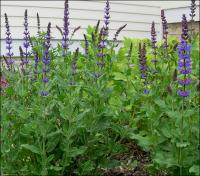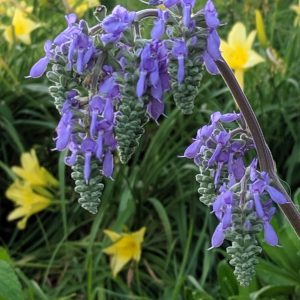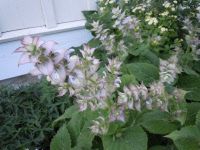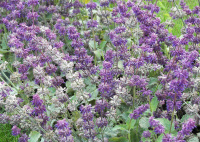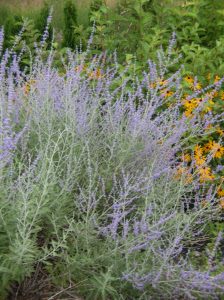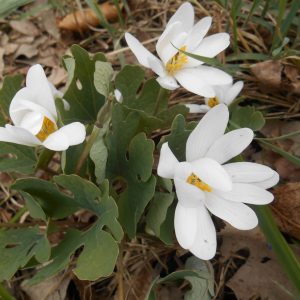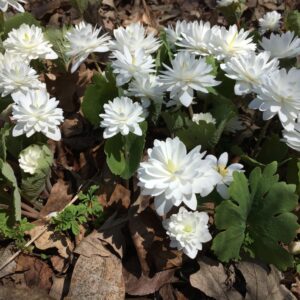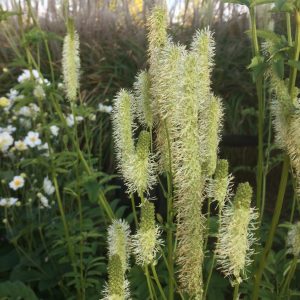Perennials & Biennials
Showing 409–416 of 511 results
-
Salvia nemorosa Meadow sage, Balkan clary Z 5-7
Purple/lavender spire dense with flowers June to September
Dense purple spires flower June to September (if cutback after 1st flush of flowers).
Size: 36" x 24"
Care: full sun in moist well-drained to well-drained soil. Drought tolerant.
Native: Europe to Central Asia.
Wildlife Value: attracts butterflies & hummingbirdsSalvia is from the Latin word salveo meaning “to heal” referring to the plant’s ancient medicinal uses. Collected before 1753.
-
Salvia nutans Nodding sage Z 5-8
Nodding clumps of sky blue flowers high over basal leaves, flower in late spring-early summer.
OUT OF STOCK
Nodding clumps of sky-blue flowers high over basal leaves, flower in late spring-early summer.
Size: 3-4’ x 18”
Care: sun to part shade in moist, well-drained soil.
Native: Balkans
Wildlife Value: attracts bees & butterflies seeking pollen and nectar. Deer resistant.Collected before 1753. Introduced to gardens in 1780 by Peter Simon Pallas (1741-1811) Berlin botanist who collected extensively in Russia. Grown in nursery of Joseph Knight, King’s Road, London. Pictured in Curtis’s Botanical Magazine Vol. 50, 1822.
-
Salvia sclarea Clary sage Reseeding Biennial Z 5-9
Extraordinary pastel panicles of cream, blue or pink, bi-toned bracts whorl around the stem spring – summer
Extraordinary pastel panicles of cream, blue or pink, bi-toned bracts whorl around the stem spring – summer
Can not ship to: Washington
Size: 3’ x 12”
Care: full sun in moist well-drained soil.
Native: Europe to Central Asia
Wildlife Value: attracts hummingbirds and butterflies. Deer resistant.Salvia is from the Latin salveo meaning “to heal” referring to the plant’s ancient medicinal uses. This species introduced to gardens from the south of Europe in 1562.
-
Salvia verticillata Lilac sage, whorley clary, Salbey Z 5-8
Muted lilac blue spikes June to October
Muted lilac blue spikes June to October, deadhead for more blooms.
Size: 24” x 18-24”
Care: sun in moist well-drained to well-drained soil. Cut back after first bloom to repeat.
Native: Spain to Ukraine, Caucasus to Iran
Wildlife Value: Butterfly magnet.Salvia is from the Latin “salveo” meaning “to heal” referring to the plant’s ancient medicinal uses. This species collected before 1753. Grown at America’s 1st botanic garden, Elgin Botanic Garden 1811.
-
Salvia yangii syn. Perovskia atriplicifolia Russian sage Z 5-9
Whorls of sky-blue flowers cover innumerable stems and their many branches creating a blue cloud from July through October
Whorls of sky-blue flowers cover innumerable stems and their many branches creating a blue cloud from July through October
Size: 4' x 4'
Care: full sun in moist well-drained to well-drained soil, Heat and drought tolerant. Cut back in spring.
Native: Afghanistan
Wildlife Value: deer & rabbit resistant, Feeds bees and honeybees
Awards: Great Plant Pick Award from Elizabeth Carey Miller Botanical Garden and Perennial Plant Association 1995 Perennial Plant of the Year.Perovskia was named for V.A. Perovski, governor of a Russian province in central Asia around 1890. Introduced to American gardens in 1904. Recommended by English garden maven Gertrude Jekyll in 1908.
-
Sanguinaria canadensis Bloodroot, Indian paint, Red Puccoon Z 3-9
Very showy, swan-white anemone-like blooms in spring from the center of glaucus, grey-green, lobed, puckered, rolled leaves. Both the leaves and root contain a red liquid. Ephemeral, dies back in summer.
Available for purchase in Spring only
Very showy, swan-white anemone-like blooms in spring from the center of glaucus, grey-green, lobed, puckered, rolled leaves. Both the leaves and root contain a red liquid. (Bloodroot) Ephemeral, dies back in summer.
Size: 6” x 12”
Care: part shade to shade in moist well-drained soil
Native: Nova Scotia to Manitoba, south to Florida and Arkansas, Wisconsin native
Wildlife Value: deer resistant. Pollen, but no nectar, makes this attractive to many different bees. Ants distribute the seeds.Sanguinaria is Latin meaning “blood,” so named for the red color of the sap. For Natives red sap used to make dye for skin, clothing, weapons and baskets. Used to induce abortions, as well as an aphrodisiac and cure sexually transmitted diseases. The root rubbed on the palm of the hand was a love charm for Ponca men. Iroquois prescribed it for diarrhea and constipation, to draw out slivers, hiccups, and generally as a panacea. It was administered to those who saw a corpse. Sioux used a weak solution to cure fever, rheumatism, congestion, and skin cancer, Ojibwa made dried roots into a necklace to prevent bleeding. 1st collected by Rev. John Banister in colonial Virginia c. 1678. According to John Bartram this was “…(C)alled by the Country People, Red Root, or Tumerick The Root dried and powdered is recommenced by Dr. Colden, as a Cure for jaundice, the Powder has been given to the Weight of a Drachm in Small Beer; and by others, for the Bite of a Rattle Snake.” Grown at Shadwell, Jefferson’s birthplace and home until it burned in 1770. Grown at America’s 1st botanic garden, Elgin Botanic Garden 1811, located where Rockefeller Center now stands. Pressed specimen in Emily Dickinson’s herbarium.
-
Sanguinaria canadensis f. multiplex Double-flowered bloodroot Z 4-8
Snowballs of pure white open to dozens of petals atop unfolding, glaucous, grey-green mitten-shaped foliage in early spring. By late spring it recedes into the earth and goes dormant. Inside its roots are same red sap as in the single form. It is sterile and can only be propagated by division.
OUT OF STOCK
Ephemeral- Available for purchase in spring only
Snowballs of pure white open to dozens of petals atop unfolding, glaucous, grey-green mitten-shaped foliage in early spring. By late spring it recedes into the earth and goes dormant. Inside its roots are same red sap as in the single form. It is sterile and can only be propagated by division.
LIMITED QUANTITIES AVAILABLE, LIMIT OF 1 PER CUSTOMER PLEASE
Size: 6” x 12”
Care: part-shade to shade in moist well drained soil. Mark its location so you don’t forget in September and dig into it.
Native: mutation of native American single-form
Wildlife Value: deer resistant
Awards: Royal Horticultural Society named this one of the top plants of the last 200 years Award of Garden Merit; Great Plant Pick 2004Discovered by Guido von Webern growing in a clump of single Bloodroots in the 7 acre plot he recently purchased at the corner of North Main St and Turner Rd in Dayton OH in 1917.
-
Sanguisorba canadensis Canada burnet, Caribon feed, Indian tobacco, Marsh lily, Greater burnet Z 3-8
White spikes August – October when little else blooms in shady places
White spikes August – October when little else blooms in shady places
Size: 3-5’ x 3’
Care: part shade to sun in moist well drained soil
Native: Newfoundland, Labrador to Georgia W to AlaskaSanguisorba is Latin meaning to soak up blood, for the plant’s reputed ability to clot blood. Collected in Canada in 1633. Collected in the U.S. by André Michaux. Grown at America’s 1st botanic garden, Elgin Botanic Garden 1811. Rand (1866) described the foliage as “elegant.”

